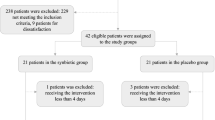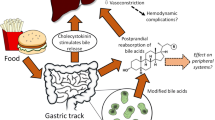Abstract
Lipids and glucides, the energetic compounds in artificial nutrition solutions, are not only “fuel” but possess other biologic functions which may influence disease evolution. Energy-yielding solutions should cover the patient’s metabolic needs but should also limit any inflammatory and oxidative stress or impairment of the immune system. This paper provides a concise overview of the clinical and metabolic properties of the most common energetic substrates employed both in enteral and parenteral nutrition.
Similar content being viewed by others
References
Stapleton RD, Jones N, Heyland DK (2007) Feeding critically ill patients: what is the optimal amount of energy? Crit Care Med 35:S535–S540
Van den Berghe G, Wouters P, Weekers F et al (2001) Intensive insulin therapy in the critically ill patients. N Engl J Med 345:1359–1367
Finney SJ, Zekveld C, Elia A, Evans TW (2003) Glucose control and mortality in critically ill patients. JAMA 290:2041–2047
Van den Berghe G, Wilmer A, Milants I et al (2006) Intensive insulin therapy in mixed medical/surgical intensive care units: benefit versus harm. Diabetes 55:3151–3159
Garber AJ, Moghissi ES, Bransome ED Jr et al (2004) American College of Endocrinology position statement on inpatient diabetes and metabolic control. Endocr Pract 10:77–82
Brunkhorst FM, Engel C, Bloos F et al (2008) Intensive insulin therapy and pentastarch resuscitation in severe sepsis. N Engl J Med 358:125–139
Wiener S, Wiener DC, Larson RJ (2008) Benefits and risks of tight glucose control in critically ill adults: a meta-analysis. JAMA 300:933–944
Dellinger RP, Levy MM, Carlet JM et al (2008) Surviving Sepsis Campaign: international guidelines for management of severe sepsis and septic shock: 2008. Crit Care Med 36:296–327
Wahed M, Geoghenan M, Powel-Tuck J (2007) Novel substrates. Eur J Gastroenterol Hepatol 19:365–370
Elia M, Engfer M, Green C, Silk D (2008) Systematic review and meta-analysis: the clinical and physiological effects of fibre-containing enteral formulae. Aliment Pharmacol Ther 27:120–145
Elia M, Ceriello A, Laube H (2005) Enteral nutritional support and use of diabetes-specific formulas for patients with diabetes. A systematic review and meta-analysis. Diabetes Care 28:2267–2279
American Diabetes Association (2008) Nutrition Recommendations and Intervention for Diabetes. A position statement of the American Diabetes Association. Diabetes Care 31:S61–S78
Volman J, Ramakers J, Plat J (2008) Dietary modulation of immune function by β-glucans. Physiol Behav 94:276–284
Wanten GJ, Calder P (2007) Immune modulation by parenteral lipid emulsions. Am J Clin Nutr 85:1171–1184
Driscol DF (2006) Lipid injectable emulsions: 2006. Nutr Clin Pract 21:381–386
Wanten G (2006) An update on parenteral lipids and immune function: only smoke, or is there any fire? Curr Opin Clin Nutr Metab Care 9:79–83
Wirtitsch M, Wessner B, Spittler A et al (2007) Effect of different lipid emulsions on the immunological function in humans: a systematic review with meta-analysis. Clin Nutr 26:302–313
Furukawa K, Yamamori H, Takagi K et al (2002) Influences of soy bean oil emulsion on stress response and cell-mediated immune function in moderately or severely stressed patients. Nutrition 18:235–240
Heyland DK (2000) Parenteral nutrition in critically ill patients: more harm that good. Proc Nutr Soc 59:457–466
Oliveira FL, Rumsey SC, Schlotzer E et al (1997) Triglyceride hydrolysis of soy oil vs fish oil emulsions. JPEN J Parenter Enteral Nutr 21:224–229
Wanten GJ, Naber AH (2004) Cellular and physiological effects of medium-chain triglycerides. Mini Rev Med Chem 4:847–857
Van den Berghe G, Wouters P, Weekers F (2001) Intensive insulin therapy in the critically ill patients. N Engl J Med 345:1359–1367
Sukkar SG, Cella F, Magliano A et al (2006) Medium-term parenteral nutrition (MTPN) with medium/long-chain triglycerides (MCT/LCT) in malnourished patients: effects on nutritional and metabolic parameters. Nutr Ther Metab 24:134–139
Waitzberg DL, Torrinhas RS, Jacintho TM (2006) New parenteral lipid emulsions for clinical use. JPEN J Parenter Enteral Nutr 30:351–367
Chambrier C, Lauverjat M, Bouletreau P (2006) Structured triglyceride emulsions in parenteral nutrition. Nutr Clin Pract 21:342–350
Reimund JM, Rahmi G, Escalin G et al (2005) Efficacy and safety of an olive oil-based intravenous fat emulsion in adult patients on home parenteral nutrition. Aliment Pharmacol Ther 21:445–454
Kelbel I, Wagner F, Wiedeck-Suger H et al (2003) Effects of n-3 fatty acids on immune function: a double blind, randomized trial of fish-oil based infusion in post-operative patients. Clin Nutr 22:59–64
Grimm H, Mertes N, Goeters C et al (2006) Improved fatty acid and leukotriene pattern with a novel lipid emulsion in surgical patients. Eur J Nutr 45:55–60
Mertes N, Grimm H, Furst P et al (2006) Safety and efficacy of a new parenteral lipid emulsion (SMOFLipid) in surgical patients: a randomized, double-blind, multicenter study. Ann Nutr Metab 50:253–259
Zachos M, Tondeur M, Griffiths AM (2007) Enteral nutritional therapy for induction of remission in Crohn’s disease. Cochrane Database Syst Rev: CD000542
Mayer K, Seeger W (2008) Fish oil in critical illness. Curr Opin Clin Nutr Metab Care 11:121–127
Wild GE, Drozdowski L, Tartaglia C et al (2007) Nutritional modulation of the inflammatory response in inflammatory bowel disease: from the molecular to the integrative to the clinical. World J Gastroenterol 13:1–7
Author information
Authors and Affiliations
Corresponding author
About this article
Cite this article
Noè, D., Lanzi, P. & Bergamaschi, E. Lipid and glucide sources in artificial nutrition. Mediterr J Nutr Metab 3, 9–14 (2010). https://doi.org/10.1007/s12349-009-0064-1
Received:
Accepted:
Published:
Issue Date:
DOI: https://doi.org/10.1007/s12349-009-0064-1




